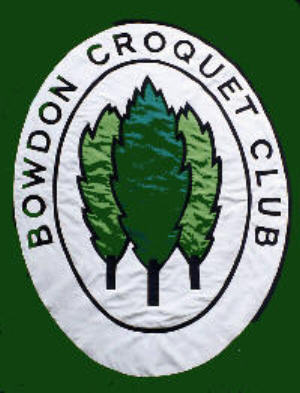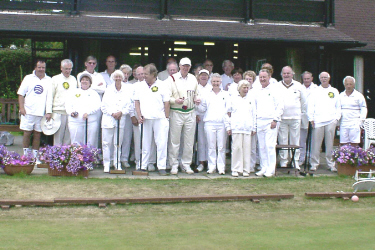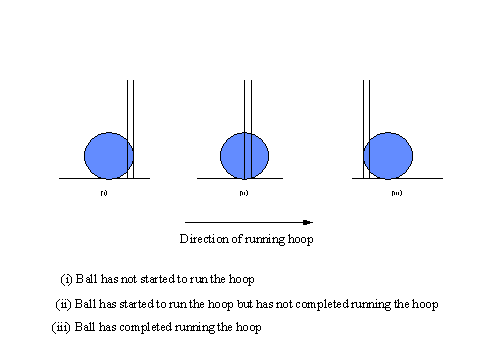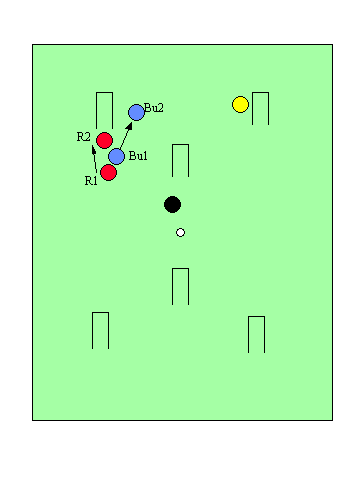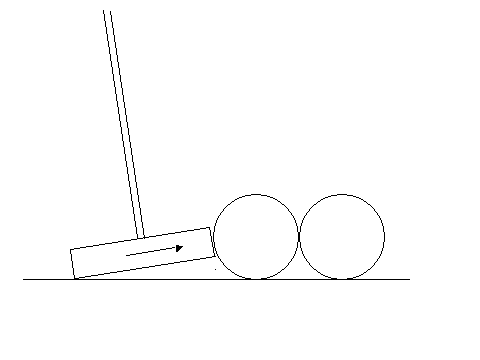|
a) The order of the Hoops
The order and direction in which
you go through each hoop is shown in the diagram on the right.
The first hoop (1) is
the one with its top painted blue; the last hoop (Rover) is the one with
its top painted red.
|
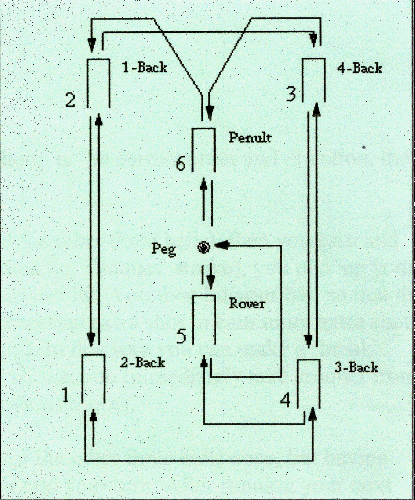
|
|
b) Scoring a Point
To score a point a hoop must be
played in this sequence and from the direction shown – you cannot skip
a hoop and come back to it later.
|
|
The peg point can only be scored
when a ball has been through all 12 hoops, hits the peg when entitled to
do so (see The Peg-Out below) or is knocked on to the peg by another ball
that has also been through all 12 hoops. Once a ball has scored its peg
point it is removed from the lawn.
If, during your turn, your ball
knocks any other ball through a hoop in the right order and direction,
then the other ball scores a point and moves on to its next hoop.
|
|
c) When is a Ball through a
Hoop?
A point is scored if the back
of the ball is past the playing side of the hoop when the ball finally comes
to rest. The diagram below shows this in more detail.
|
|
2. The Sequence of Shots
If your ball ‘runs’
a hoop, i.e. goes through a hoop in the correct order and direction, then
you earn an extra turn.
If your ball makes a ‘roquet’
(by hitting one of the other three balls), then you earn an extra two shots.
On the first of these shots (called the ‘croquet’ stroke), you pick up your
ball and place it anywhere against the ball it has just hit. You then hit
your ball so that the two balls move and after this you can use your second
extra shot to earn more extra shots (by hitting another ball or running
another hoop). In this way you can make a ‘break’.
N.B. If you roquet another ball on the croquet stroke, you immediately
take croquet from it and lose your second extra shot from the previous roquet.
In each turn, you are allowed to ‘roquet’ each of the other three balls
once, but having done that you must then run your next hoop, or end your
turn. After running your next hoop you, effectively, start your turn again
and can roquet all three balls again before having to go through your next
hoop in sequence.
If you fail to win extra shots because you miss a croquet or fail to
run a hoop, then your turn ends.
|
3. Handicapping
Each player is allocated a handicap
which takes the form of extra turns during the game, e.g. if you turn ends
you can elect to continue with the break you are playing (with the same
ball).
A handicap maximum of 26 ‘bisques’
may be given to a player. However, the number of bisques allocated in a
game is determined by the difference between the two players’ handicaps.
These bisques (white sticks) are placed in the ground and ceremonially removed
by the out player when instructed to do so by the person in play.
|
4. An Example of a 4-Ball Break
There is described below, in diagramtic format,
an example of the sequence of shots required to be made to execute a 4-ball
break. There is, however, also available a Moving
Example of a 4-Ball Break in Powerpoint, if this software is loaded
on your PC.
|
|
Imagine that you are playing with red, which is for hoop 1.
Then a typical sequence of shots might be: |
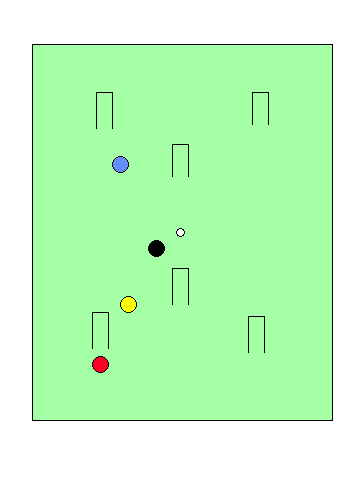
|
|
1. Run hoop 1, earning one extra shot.
|
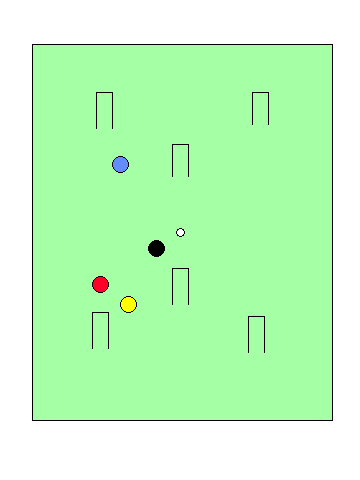
|
2. Roquet yellow,
earning two extra shots.
|
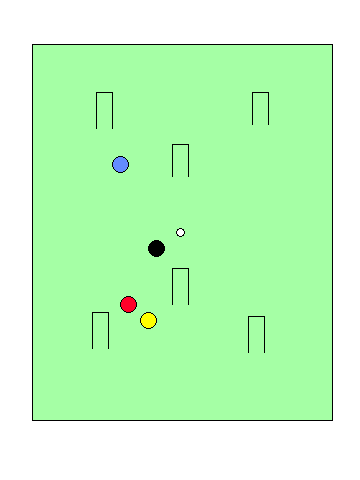
|
3.
Place your ball (R1) against yellow (Y1) and
play a croquet stroke (the first extra shot),
putting yellow into a useful position (Y2) and
getting red close to black (R2).
|
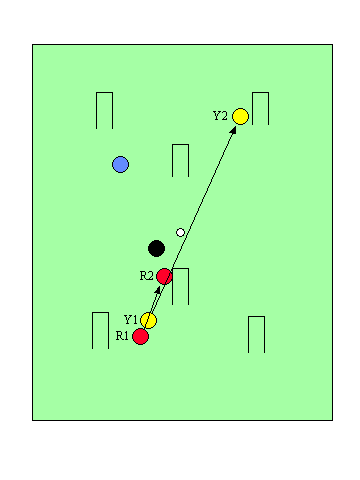
|
4. Roquet black (the second extra shot) earning two more extra shots.
|
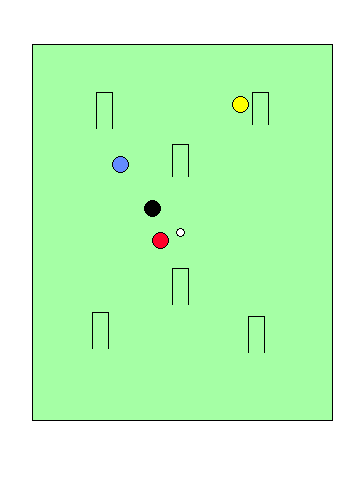
|
5. Place your ball (R1) against black (Bk1) and play a croquet stroke,
putting black into a useful position (Bk2) and getting red close to blue
(R2).
|
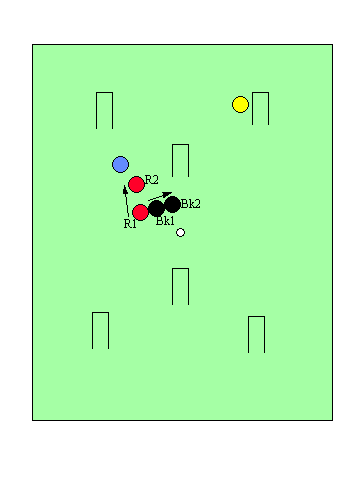
|
6. Roquet blue, earning two extra shots.
|
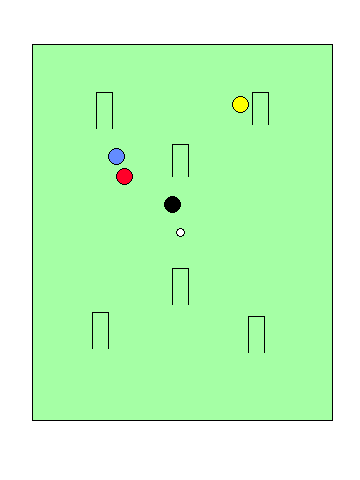
|
7. Place your ball (R1) against blue (Bu1) and
play a croquet stroke, putting blue into a useful position (Bu2) and getting
red in front of hoop 2 (R2).
|
|
8. Run hoop 2 and earn one extra shot.
Provided that
you make no mistakes you can continue with similar shots and get red all
the way round. Breaks like this can be made using two, three or all four balls.
Croquet tactics aim to get you in position
to make a break and to prevent your opponent doing so.
|
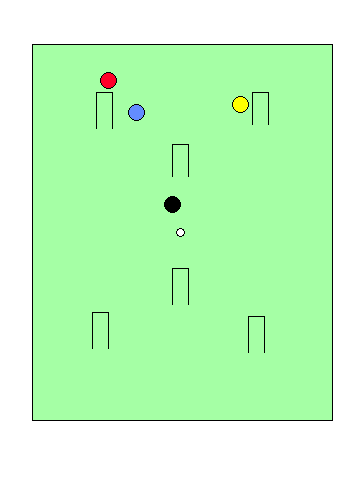
|
|
The following
points will help you when you are manoeuvring for a position:
a). If your opponent’s balls are apart, put your balls
together.
b). If your opponent’s balls are together, do not leave
your balls too close together (a good player will roquet
his other ball, take croquet towards your pair,
roquet one of your balls, take croquet so that his ball stops
in line to rush your other ball to his next hoop,
and so start a break).
c). A ball by a hoop makes that hoop easy to run. So,
at the end of your turn, do not leave a ball at your opponent’s next hoop.
d). To make it difficult for your opponent to make a
break, leave your balls at the edge of the lawn at the end of your turn.
To help you in future turns leave your opponent’s balls in the middle of
the lawn or, better still, by your next hoops.
e). Leave your opponent’s balls far enough apart to prevent
them roqueting other balls.
f). If you hit a long shot at your opponent’s balls,
make sure that if you miss you end up well past them.
g).
At the end of your turn try to leave yourself
a rush to somewhere useful. Then, if your opponent fails to get
a break going, you can take advantage of the rush
in your next turn.
Note 1: You
can roquet the other three balls in any order, but you can only roquet
each of them once before you have to go through your next hoop. However,
in moving from one hoop to the next, you don’t necessarily have to roquet
all three other balls, although the more roquets you make, the easier it
is!
Note 2: Extra shots are not
cumulative. If you run a hoop and, in the same stroke, roquet a ball on the
other side of the hoop, you immediately take croquet from that ball and
do not receive an additional extra shot for running the hoop.
|
5. The Start
|
|
a) The Toss
If
you win the toss you can either choose which colour balls to play with (red
and yellow or black and blue) OR choose to go in first or second, e.g. if
you win the toss and decide to go first, then your opponent has the choice
of colours. Alternatively, if you win the toss and choose to play with
particular colours, then your opponent can decide
to go in first or second.
|
b) Playing the Balls on to the Lawn
The balls are played on to the lawn from any point on either
of the two start (or ‘baulk’) lines. These are imaginary lines one yard
inside the North or South boundaries, stretching from a point one yard from
the left-hand boundary to the mid-point of the lawn (see diagram on the right).
|
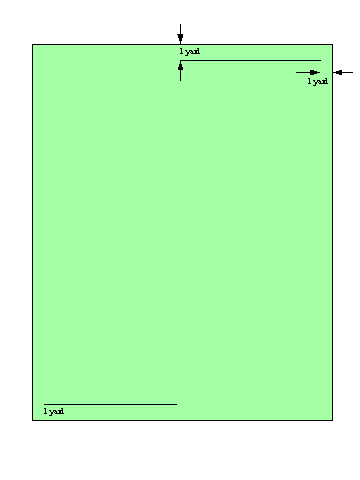
|
If you go first, then you play either of your two balls on
to the lawn from any place on either baulk line. If you run the first hoop
in the right direction then you get another shot, as explained above. If
you are lucky and run the second hoop with this shot then you get another
shot.
Your opponent then
plays either of his two balls on to the lawn from either of the baulk lines
(not necessarily the same baulk line that you used in the first turn). As
before, if he runs a hoop then he earns an extra shot. Alternatively, if
he hits your ball then he earns two extra shots.
At the end of your
opponent’s turn, you must then play your second ball on to the lawn from
either baulk line, earning extra shots if you hit any other ball on the lawn
or run a hoop in order.
In the fourth turn,
your opponent has to play the fourth ball on to the lawn from either baulk
line, earning extra shots as before. Once all four balls are on the lawn,
you take alternate turns with your opponent. Before the start of each turn
you can decide which of your two balls you want to play but, having started
to play the turn, you must continue to play the same ball throughout that
turn.
|
6.
The Mid-Game
Play proceeds with each player
having alternate turns and trying to make as many hoops as possible in
each turn. At the end of each turn the player should replace the coloured
clips (which match the balls) on the hoops to indicate which each ball
is for.
|
7. Replacing Balls on the
Lawn
A ball is off the lawn when any
part of it overhangs the inside edge of the boundary. At the end of each
stroke, any ball that is off the lawn is immediately replaced one yard inside
the boundary at right angles to the point where it went off.
If you roquet a ball and it goes
off the lawn, that ball is replaced one yard inside the boundary and you
put your ball against it to play your croquet stroke. If you send either
ball off on a croquet stroke, then the ball is replaced one yard inside
the boundary and your turn ends.
N.B. If you go off the lawn after running a hoop, your turn does not
end. You simply replace the ball in from the boundary and continue.
|
8. The Peg-Out
After one of your balls has scored
12 hoops it becomes a ‘rover’ ball. You can score the peg point by hitting
your ball against the peg with your mallet. However, you can only do this
(in handicap play) if your other ball is also a rover. Once a ball is pegged-out
it is immediately removed from the lawn, so if you peg out one of your
balls, there will only be three balls left in the game. You have to decide
whether this is going to help or not – part of the tactics of the game!
It is more common practise to peg out your opponent’s rover ball, leaving
him with only one ball.
You can peg out any other rover
ball (either your own or your opponent’s) by knocking it on to the peg
with your own rover ball. This can happen in either the roquet or a croquet
stroke but, if in the roquet stroke your turn ends as you have no ball
from which to take croquet as the pegged-out ball is immediately taken
off the lawn.
Having pegged-out your opponent’s
rover ball, you can then peg out your own ball if you wish, even if your
other ball is not a rover. This can happen in the same turn if you are entitled
to another stroke, or in any later turn, leaving only two balls on the
lawn and an exciting finish.
|
9. Wiring and
Lifts
This is rather like being snookered.
If, at the start of your turn, either a hoop or the centre peg makes it
impossible to hit both sides of all other balls on the lawn with the ball
you wish to play and provided that
the ball you want to play was placed there by your opponent, then you are
allowed the option of picking up that ball and playing it from either baulk
line. This option is called a ‘lift’. Remember – you do not have to take
a lift if you are wired; you must make a judgement as to whether it gives
you a better position from which to play.
If any part of your ball is within
the jaws of a hoop at the start of your turn, then it is regarded as wired
and so you can claim a ‘lift’ if it was put there by your opponent.
|
10. Timed Games
If you agree with your opponent
or rules declare that a game must be finished within a certain time frame
then, when time is up, the person in play finishes his or her turn and
then the opponent has a last turn. However, once time has been ‘called’,
neither player may take further bisques.
The winner is the player who has
scored most points at the end of this last turn. If the scores are level
after the last turn then play continues (when any outstanding bisques may
now be taken) until one player scores a hoop and wins.
|
11. Technique
a) Making the Shots
Having tried out the game, you might like to practise the various types
of croquet stroke:
|
Take-Off: In this
stroke the balls are placed so that your own ball can be struck almost
directly to the point where you wish to send it and, in doing so, it may
only move the other ball a very short distance. The more you hit into the
other ball the greater distance that ball will travel.
N.B. It is imperative that the
object ball moves, if only fractionally. |
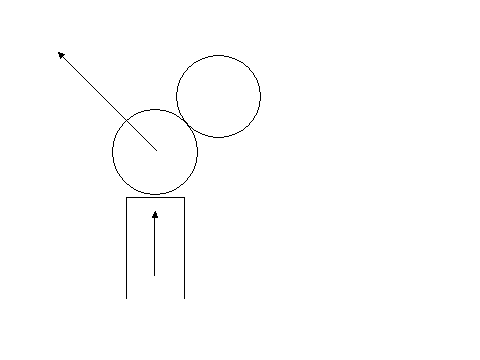
|
Stop-Shot: Use this shot if you want to restrict the distance that
you own ball travels. Play the shot so that your mallet stops/does not follow
through on impact.
|
|
Roll-Shot: Use this shot if you
want to send the two balls about the same distance. This is achieved by
striking your ball above the centre and following through.
|

|
|
Split-Shot: Use this shot when
you want to send the two balls about the same distance but in different directions.
This is, basically, the same as a Roll shot, but the aim has to be at a
point about half-way between the positions you wish the two balls to reach.
|
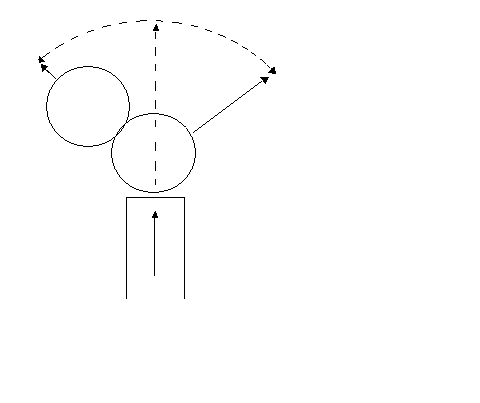
|
|
b) Faults
You commit a fault if you:
i. push your
ball with your mallet;
ii. hit your ball more
than once;
iii. crush your ball between
a hoop or the peg and your mallet;
iv. fail to move or shake
either ball in a croquet stroke.
When a fault has
been committed, the striker’s turn ends and the balls are replaced where
they were when the fault occurred. At this point, a bisque can be taken if
so desired, and the stroke replayed.
|
12.
Some Popular Misconceptions
i. You no longer
have to play the balls in the sequence of colours on the peg. At the start
of each turn you can
decide which of your two balls you want to
play, according to the tactical situation. Once you have started
the turn with one ball you must play with that
ball for the whole of that turn.
ii. You
are not allowed to put your foot on your ball when playing the croquet stroke.
If any ball touches your
body or clothing, that is a fault. The balls
are replaced where they were and your turn ends.
iii. You are allowed
to roquet other balls and earn other strokes before running hoop 1.
|
13.
Terminology
The definition of all terms
used above can be found in the Glossary of Terms.
|
